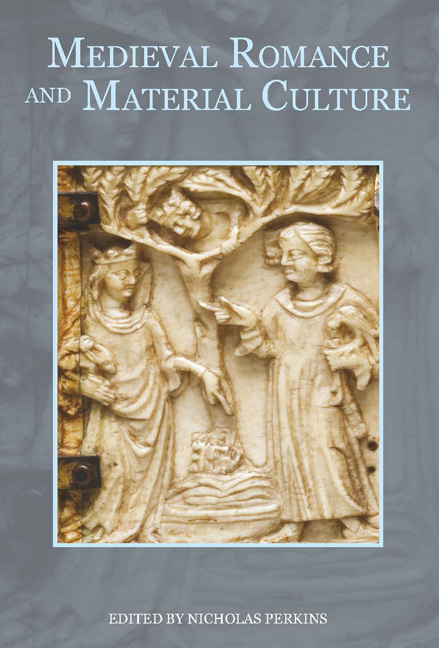Book contents
- Frontmatter
- Contents
- List of Illustrations
- List of Contributors
- Acknowledgements
- Abbreviations
- 1 Introduction: The Materiality of Medieval Romance and The Erle of Tolous
- 2 Courtly Culture and Emotional Intelligence in the Romance of Horn
- 3 Emplaced Reading, or Towards a Spatial Hermeneutic for Medieval Romance
- 4 Devotional Objects, Saracen Spaces and Miracles in Two Matter of France Romances
- 5 The Werewolf of Wicklow: Shapeshifting and Colonial Identity in the Lai de Melion
- 6 ‘Ladyes war at thare avowing’: The Female Gaze in Late-Medieval Scottish Romance
- 7 The Evolution of Cooperation in The Avowyng of Arthur
- 8 Ritual, Revenge and the Politics of Chess in Medieval Romance
- 9 Adventures in the Bob-and-Wheel Tradition: Narratives and Manuscripts
- 10 Reading King Robert of Sicily's Text(s) and Manuscript Context(s)
- 11 The Circulation of Romances from England in Late-Medieval Ireland
- 12 The Image of the Knightly Harper: Symbolism and Resonance
- 13 Carving the Folie Tristan: Ivory Caskets as Material Evidence of Textual History
- 14 Romancing the Orient: The Roman d'Alexandre and Marco Polo's Livre du grand Khan in Oxford, Bodleian Library MS Bodl. 264
- 15 The Victorian Afterlife of The Thornton Romances
- Index
10 - Reading King Robert of Sicily's Text(s) and Manuscript Context(s)
Published online by Cambridge University Press: 05 May 2015
- Frontmatter
- Contents
- List of Illustrations
- List of Contributors
- Acknowledgements
- Abbreviations
- 1 Introduction: The Materiality of Medieval Romance and The Erle of Tolous
- 2 Courtly Culture and Emotional Intelligence in the Romance of Horn
- 3 Emplaced Reading, or Towards a Spatial Hermeneutic for Medieval Romance
- 4 Devotional Objects, Saracen Spaces and Miracles in Two Matter of France Romances
- 5 The Werewolf of Wicklow: Shapeshifting and Colonial Identity in the Lai de Melion
- 6 ‘Ladyes war at thare avowing’: The Female Gaze in Late-Medieval Scottish Romance
- 7 The Evolution of Cooperation in The Avowyng of Arthur
- 8 Ritual, Revenge and the Politics of Chess in Medieval Romance
- 9 Adventures in the Bob-and-Wheel Tradition: Narratives and Manuscripts
- 10 Reading King Robert of Sicily's Text(s) and Manuscript Context(s)
- 11 The Circulation of Romances from England in Late-Medieval Ireland
- 12 The Image of the Knightly Harper: Symbolism and Resonance
- 13 Carving the Folie Tristan: Ivory Caskets as Material Evidence of Textual History
- 14 Romancing the Orient: The Roman d'Alexandre and Marco Polo's Livre du grand Khan in Oxford, Bodleian Library MS Bodl. 264
- 15 The Victorian Afterlife of The Thornton Romances
- Index
Summary
The earliest known extant copies of the Middle English pious romance Roberd of Cisyle (henceforth Robert) survive in the compendious Vernon manuscript (Oxford, Bodleian Library MS Eng. poet. a. 1) and its sister, the Simeon manuscript (London, British Library Additional MS 22283), both dated to around the last decade of the fourteenth century. Overall Robert is extant in ten manuscripts dated from the end of the fourteenth to the end of the fifteenth century. Its length in these witnesses ranges from 79 to 516 lines, with the ‘standard’ version being 444 lines (in Vernon and Simeon). The distribution of the extant manuscripts is broad geographically and linguistically, attesting to the popularity of this text in later medieval England. By the time the text was selected for inclusion in these manuscript books, however, the story had been popular for a long time. Its analogues are numerous and wide- spread in a number of languages and geographical areas across Europe. This is not surprising, given the exemplary nature of the story, focused on the fall of a king from power due to his excessive pride. It fulfils the expectations of a medieval audience that God will overthrow the mighty rulers of this world for their overweening pride.
Little or no attention, however, has been paid by modern scholars to the cultural significance of this text apart from its penitential and didactic features. It is commonly relegated to the category of ‘pious romances’ (on which see below) and its core message reduced to that of a lesson in humility intended for ‘Everyman’. Close scrutiny of the manuscript contexts in which Robert survives, including formal features, reveals that much can be gained by reading this text afresh and in the material contexts in which it survives. The examination of the material appearance of the text on the page reveals previously unexplored generic affiliations of manuscript versions of Robert, making a case for a combined secular and spiritual reading of the romance, rather than a purely didactic one, as has been the case in earlier studies.
- Type
- Chapter
- Information
- Medieval Romance and Material Culture , pp. 165 - 182Publisher: Boydell & BrewerPrint publication year: 2015

